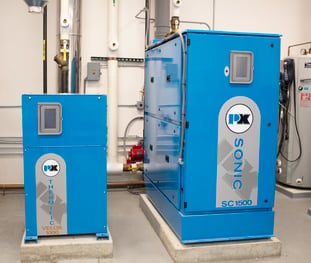 Eventually, all commercial heating systems need to be replaced – and whether you replace one unit, or five, it will require a significant investment in time and money. In upgrading your system with the latest technology can offer in condensing equipment, high system efficiency, building management and connectivity, the cost to retrofit your boiler room can escalate quickly.
Eventually, all commercial heating systems need to be replaced – and whether you replace one unit, or five, it will require a significant investment in time and money. In upgrading your system with the latest technology can offer in condensing equipment, high system efficiency, building management and connectivity, the cost to retrofit your boiler room can escalate quickly.
Fortunately, there is an additional option. You can choose to update your boiler room while saving on installation cost and optimizing your heating system efficiency by considering a hybrid system approach.
What is a Commercial Hybrid Heating System?
Hybrid systems consist of one or more condensing boilers, combined with one or more non-condensing boilers that perform the same function. It is designed to both, accommodate building loads, and provide instant savings on the cost of installation.
The design of a hybrid system is calculated to handle the building load with the condensing boiler(s) until it can no longer condense or maintain high efficiency levels. Condensing boilers are more efficient when maintaining lower temperatures and lower percentage of boiler modulation (1-50%). Once they begin exceeding certain parameters, they become less efficient.
In a hybrid system, the temperature required to heat the building on a given day would be used to calculate the building load and size the unit(s) accordingly. For example, an engineer would select a specific building and calculate the energy required down to a specific outdoor temperature without exceeding 150°F boiler temperature. When the system calls for 150°F and below the condensing boiler will run, but when the system calls for 151°F or above the non-condensing boilers will kick-in to accommodate the load. This is assuming that the system will operate at a 30° delta T, so that the return temperature is at 120°F to 130°F. This will cause the condensing boiler(s) to provide high efficiency to the best of its capacity.
.png?width=557&name=Hybrid%20Boiler%20Piping%20System%20Pre-heat%20Tees%20(2).png)
*Piping diagrams can change based on proper application. The diagram below is a representation of the components needed for a commercial hybrid heating system.
Proper Control of a Hybrid Heating System
Applying the right control to a hybrid system design is extremely critical for proper boiler sequencing, and to attain the most condensing run-time during boiler operation. The end user must be able to prioritize the start sequence of the boiler system. In the case of mild weather, the condensing boilers must have priority in satisfying building load requirements. When the weather changes, and the outdoor temperature drops below the point of boiler condensation (90%+ efficiency), the control should engage the non-condensing boiler(s). At this point the difference in efficiency between the two types of boilers should be about 1-1 ½ %. The condensing boiler will now be operating at 88%, while the non-condensing boiler operates at 86.5-87% efficiency.
Why Install a Hybrid Heating System?
The benefits of installing a hybrid system include increased savings on installation costs and maximized efficiency. A non-condensing boiler can be about 40% more cost effective than a condensing boiler. When replacing a multi boiler system, purchasing a multiple condensing boilers can become more expensive than a combination of condensing and non-condensing boilers.
 Prevent Challenges with a P-K Hybrid System Solution
Prevent Challenges with a P-K Hybrid System Solution
Lacking a good boiler control system that can effectively manage the boiler input based on the temperature requirements of a building can become a great disadvantage when setting up a hybrid system. In which case, the building loads would need to be calculated in a way that a portion of the boiler plant will be condensing and the other portion will not be condensing.
In the past, setting up a hybrid system could have been intimidating for both the system designer and the installer. Those times are over! With recent boiler technology breakthroughs, controls are now able to achieve boiler sequencing and manipulate loads based on the type of boiler and temperature requirements.
The Patterson-Kelley NURO® Touch-Screen Control has the flexibility to control hybrid system applications. Just with one click within the settings option, the control can walk you through the easy steps of setting up the appropriate parameters. Even if the boilers are connected to a building management system, properly setting the hybrid system with the NURO® control can be a piece of cake!

